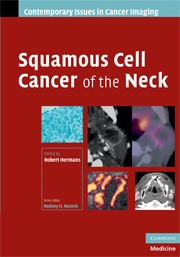Book contents
- Frontmatter
- Contents
- List of contributors
- Series Foreword
- Preface to Squamous Cell Cancer of the Neck
- 1 Introduction: epidemiology, pathology and clinical presentation
- 2 Radiotherapy and chemoradiotherapy of the head and neck
- 3 Surgery of the orocervical region
- 4 Laryngeal and hypopharyngeal cancer
- 5 Oral cavity and oropharyngeal cancer
- 6 Nasopharyngeal cancer
- 7 Neck and distant disease spread
- 8 Post-treatment imaging
- Index
- Plate section
- References
4 - Laryngeal and hypopharyngeal cancer
Published online by Cambridge University Press: 24 August 2009
- Frontmatter
- Contents
- List of contributors
- Series Foreword
- Preface to Squamous Cell Cancer of the Neck
- 1 Introduction: epidemiology, pathology and clinical presentation
- 2 Radiotherapy and chemoradiotherapy of the head and neck
- 3 Surgery of the orocervical region
- 4 Laryngeal and hypopharyngeal cancer
- 5 Oral cavity and oropharyngeal cancer
- 6 Nasopharyngeal cancer
- 7 Neck and distant disease spread
- 8 Post-treatment imaging
- Index
- Plate section
- References
Summary
Introduction
Laryngeal and hypopharyngeal neoplasms are squamous cell carcinomas in up to 95% of patients. The most important established risk factor is chronic use of tobacco and alcohol, especially when used in combination. The evaluation of laryngeal and hypopharyngeal tumor extension is based on clinical examination, endoscopic examination and computed tomographic (CT) imaging. Spiral CT and, more recently, multidetector CT offer an accurate examination of the upper aerodigestive tract with the advantage of rapid acquisition of data in a highly reproducible way.
Computed tomographic technique
Scan issues
The primary role of imaging is to evaluate local and locoregional tumor extension, in conjunction with the clinical examination. It is important to evaluate the entire aerodigestive tract because multiple sites of tumor are not rare in these patients. Consequently, CT images are acquired from the nasopharynx to the cervicomediastinal junction.Using multidetector CT (MDCT), images can then be reconstructed to approximately 1 mm. Multiplanar reformatting is then possible for the pharyngolaryngeal area and the cervical lymph nodes areas.
The CT study can be extended to include the thoracomediastinal area to look for other primary tumors or metastatic lesions.
The advantages of modern MDCT include:
exploration of the entire pharyngolaryngeal area in a short acquisition time (< 20 s)
reduction of motion and deglutition artefacts
the possibility of obtaining images during phonation or the Valsalva maneuver
the ability to perform multiplanar reformatting in the coronal or sagittal planes
optimization of scan timing to obtain optimal tissue contrast medium, particularly relating to the neck vessels
comprehensive evaluation of the neck lymph nodes, from the skull base to the supraclavicular area.
- Type
- Chapter
- Information
- Squamous Cell Cancer of the Neck , pp. 48 - 66Publisher: Cambridge University PressPrint publication year: 2008



